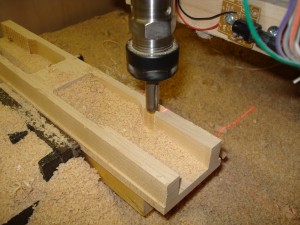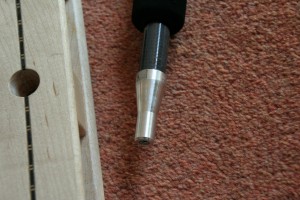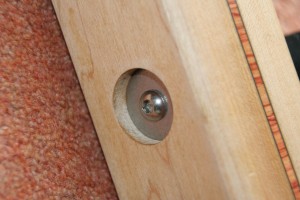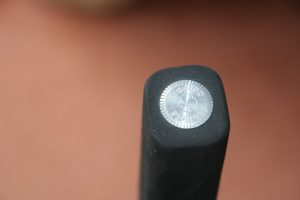Construction
I set out to design a mallet with the traditional look and feel of a hardwood mallet, but with the performance of a peripherally weighted design, that might otherwise be built using composite materials. To do this I needed to reduce the mass of wood, by making it a hollow structure, and then adding back the weight as close to the mallet end faces as I could manage. After some experimentation I settled on a design using two clam shell components, each hollowed out, so that when bonded back together, they formed a shell onto which the end caps could then be attached.
 The routed parts look like this, and are made from Maple, a tough and resilient hardwood, that finishes well, and seems to stand up to the knocks and scrapes of match-play. All my early mallets were hand routed, but to achieve more consistency, (and avoid a tedious job), I have built myself a computer controlled router to do the job for me.
The routed parts look like this, and are made from Maple, a tough and resilient hardwood, that finishes well, and seems to stand up to the knocks and scrapes of match-play. All my early mallets were hand routed, but to achieve more consistency, (and avoid a tedious job), I have built myself a computer controlled router to do the job for me.
I then put an inlay of cross banded tulip wood into a routed groove where the top and bottom parts meet and another cross banding inlay on the top adds the sight line.
End caps made of Tufnol are attached and bonded in place with lead and resin, to bring the total weight up to the design value. I take particular care to ensure that the end faces are perpendicular to the sight lines, as this is the most critical dimension of a mallet. A 100mm ball at 10m represents an angular target of around 1/2 degree, so for the mallet to have no significant contribution to inaccuracy of aiming, the squareness needs to be less than this. My criteria in manufacture is around 1/10 degree. I prefer Tufnol to metal for end-caps as this seems a more appropriate material, that will be “kinder” to the other equipment, but I realise that this may be a personal prejudice.
A tapered hole in the centre then takes a turned component that allows a carbon fibre shaft to be attached to take the handle parts.
 I use carbon fibre for the shafts of all my mallets. It seems to offer many advantages, of lightness combined with stiffness, but provides enough flex to aid the player. People using my mallets, seem to agree that the flex in a carbon fibre shaft makes the mallet easier to use. I think that a slightly flexible shaft allows the maximum transfer of momentum into the struck ball, so reducing the effort needed, and reduced effort and strength allows most people to be more accurate.
I use carbon fibre for the shafts of all my mallets. It seems to offer many advantages, of lightness combined with stiffness, but provides enough flex to aid the player. People using my mallets, seem to agree that the flex in a carbon fibre shaft makes the mallet easier to use. I think that a slightly flexible shaft allows the maximum transfer of momentum into the struck ball, so reducing the effort needed, and reduced effort and strength allows most people to be more accurate.
 I don’t know if there is solid science behind that view, but it sounds reasonable to me. Also I believe the flex of a carbon shaft is helpful in performing a good stop shot. The shaft is bonded to the turned taper component that attaches to the head.
I don’t know if there is solid science behind that view, but it sounds reasonable to me. Also I believe the flex of a carbon shaft is helpful in performing a good stop shot. The shaft is bonded to the turned taper component that attaches to the head.  The handles are then formed out of a solid foam material, which can be worked using similar techniques to wood, and this is then fitted to the shaft to complete the mallet.
The handles are then formed out of a solid foam material, which can be worked using similar techniques to wood, and this is then fitted to the shaft to complete the mallet.
